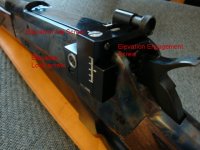Hey All,
I have a Winchester 94 trapper in 44 mag that has a Williams "Fool Proof" rear peep sight installed.
I took it to the range today to do some testing with some reloads that I had made. The reloads shot well, but were slightly off point of aim. I adjusted the elevation to move the point of impact then test fired it some more. My shots were a little eratic - I thought the sight might be loose so I tightened the little screw that holds the elevation adjustment in place. I also adjusted the screw on the side of the sight (that is called the "angled locking bushing screw" on the instructions that came with the sight).
After I made the adjustment, everything seemed to hit point of aim and my shots were tight at 25 and 50 yards. The gun was shooting great, till I tried to make some more elevation adjustments when I wanted to shoot it at 100 yards.
When I tried to adjust the elevation later on, nothing would happen. I loosed both the little screw and the angled locking bushing screw, then tried turning the elevation adjustment screw. It would click and turn, but the sight would not move up or down.
I'm not sure what to do. The sight seems to be stuck and cannot be moved up or down. The windage adjustment works fine, but the elevation adjustment no longer responds.
Any ideas on what to try? did I damage the sight irreparably?
Thanks!
I have a Winchester 94 trapper in 44 mag that has a Williams "Fool Proof" rear peep sight installed.
I took it to the range today to do some testing with some reloads that I had made. The reloads shot well, but were slightly off point of aim. I adjusted the elevation to move the point of impact then test fired it some more. My shots were a little eratic - I thought the sight might be loose so I tightened the little screw that holds the elevation adjustment in place. I also adjusted the screw on the side of the sight (that is called the "angled locking bushing screw" on the instructions that came with the sight).
After I made the adjustment, everything seemed to hit point of aim and my shots were tight at 25 and 50 yards. The gun was shooting great, till I tried to make some more elevation adjustments when I wanted to shoot it at 100 yards.
When I tried to adjust the elevation later on, nothing would happen. I loosed both the little screw and the angled locking bushing screw, then tried turning the elevation adjustment screw. It would click and turn, but the sight would not move up or down.
I'm not sure what to do. The sight seems to be stuck and cannot be moved up or down. The windage adjustment works fine, but the elevation adjustment no longer responds.
Any ideas on what to try? did I damage the sight irreparably?
Thanks!

